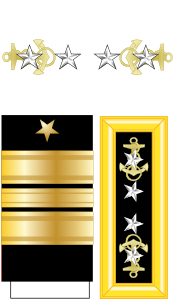Admiral of the Navy
| Admiral of the Navy | |
|---|---|
 Insignia for Admiral of the Navy. | |
| Country | |
| Service branch | |
| Rank | Six-star |
| NATO rank code | OF-11 |
| Non-NATO rank | O-12 |
| Formation | 1899 |
| Next lower rank | Fleet admiral |
| Equivalent ranks | General of the Armies (United States Armed Forces) |
The Admiral of the Navy (abbreviated as AN) is the highest possible military rank in the United States Navy. The rank is intended as an "admiralissimo" type position which is senior to the rank of Fleet Admiral.
The rank has only been awarded once, to George Dewey, in recognition of his victory at Manila Bay in 1898. The United States Congress authorized a single officer to hold the rank of admiral and promoted Dewey to this rank in March 1899. By a Congressional Act of March 24, 1903, Dewey's rank was established as Admiral of the Navy, effective retroactive to March 1899. The text of the act read as follows:
Be it enacted by the Senate and the House of Representatives of the United States of America in Congress assembled, That the President is hereby authorized to appoint, by selection and promotion, an Admiral of the Navy, who shall not be placed upon the retired list except upon his own application; and whenever such office shall be vacated by death or otherwise the office shall cease to exist.[1]
It was further specified that this rank was senior to the four-star rank of admiral and was equal to Admiral of the Fleet in the British Royal Navy. The rank lapsed with the death of Admiral Dewey on January 16, 1917. In 1944, upon the establishment of the five-star Fleet Admiral rank, the Navy stated that Dewey's rank was senior but did not officially state it was a six-star rank.
Six-star rank
This section needs additional citations for verification. (July 2016) |
In 1944, with the establishment of the rank of Fleet Admiral, the Department of the Navy specified in a Bureau of Navigation memo that "the rank of Fleet Admiral of the United States Navy shall be considered the senior most rank of the United States Navy". As George Dewey had been deceased for nearly thirty years, no comparison between his rank and that of Fleet Admiral was made until 1945. At that time, during the preparations for the invasion of Japan, the possibility was raised of promoting one of the serving United States Fleet Admirals to "six-star rank" should the Army take a similar measure by promoting Douglas MacArthur to the rank of General of the Armies. Nothing official was ever published by the Navy Department concerning a Navy six-star rank and no comparison between the Admiral of the Navy, General of the Armies, and Fleet Admiral rank was ever announced.
In 1981, upon the death of Omar Bradley, the United States House Committee on Armed Services inquired of the Institute of Heraldry as to the procedure should a Navy officer ever be awarded a six-star rank equivalent of General of the Armies. The response to Congress stated:
Should an officer of the Air Force or Navy be promoted to six-star rank, that officer should be entitled to the six-star insignia with a service specific crest.[2]
While the Institute did not specifically mention the rank of Admiral of the Navy, a prototype shoulder board for a "Navy six-star admiral" was designed in sketch. This image was later made available through the Naval History and Heritage Command. The insignia did not address the sleeve stripe insignia for such a rank and only provided details for the shoulder boards typically worn on summer and full dress white uniforms.
References
- ^ CHAP 378, "An act creating the office of Admiral of the Navy", United States Congress
- ^ Congressional Record 1981, Cong. 97 Sess. 1 – Part 8, "Promotion of other service branches to General of the Armies of the United States".
